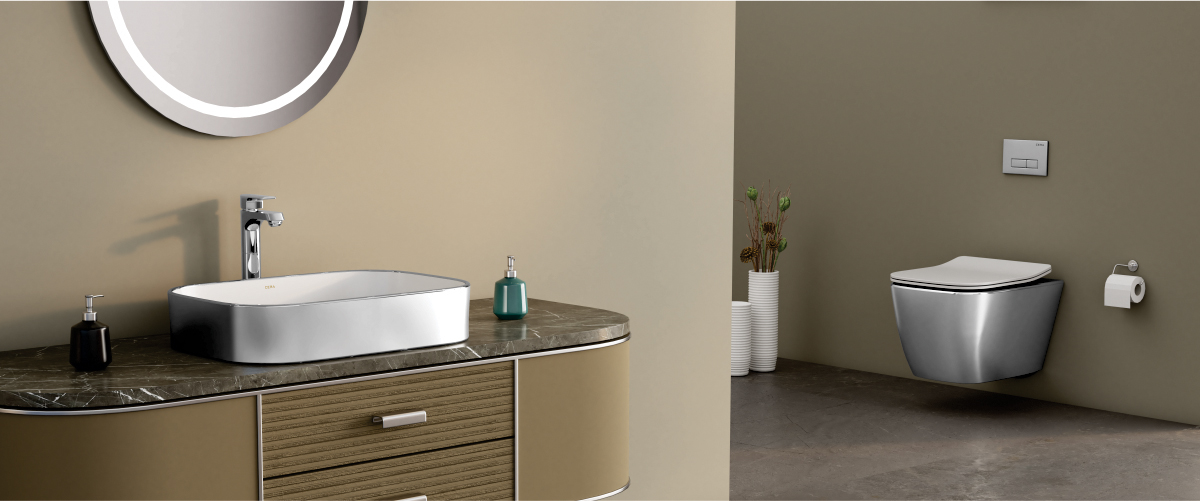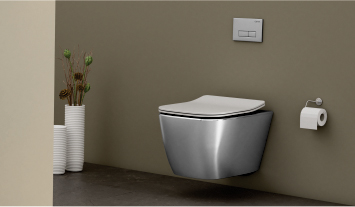- Sanitaryware
Every drop of water counts, especially in places where water supply is limited. A water-efficient cistern helps use only the required amount of water, reducing wastage. This small change can save thousands of litres every year, benefiting both the environment & your wallet.
In this blog, we will discuss cisterns, their types, components, functions, & working mechanism.
What is a Cistern?
Toilet cisterns also known as flush tanks, flushing cisterns, or water tanks, are an important part of a modern toilet system. They are designed to hold water and release it to clean the toilet bowl after use, helping flush waste into the sewage system.
Types of Toilet Cisterns
● Close-Coupled Cisterns: These tanks are fixed right on top of the toilet bowl. They are small & simple to install.
● Concealed Cisterns: They are hidden inside the wall or behind a panel. These flush tanks will give your bathroom a neat & modern look. Concealed cisterns also save space but may be tricky to repair.
● Wall-Hung Cisterns: These are mounted on the wall, which saves floor space & gives the bathroom a clean and stylish appearance. They are used with wall-hung toilets.
● Low-Level Cisterns: These cisterns are placed lower on the wall, at the same height as the toilet. They are usually seen in traditional bathroom designs.
● High-Level Cisterns: They are installed high above the toilet on the wall with a long pipe. They give a classic look.
● Dual-Flush Cisterns: These flush tanks offer two flush options: a half flush for liquid waste & a full flush for solid waste. They help to save water.
● Polymer Cisterns: Made from durable polymer materials, these cisterns offer lightweight strength, corrosion resistance, and long-lasting performance. Polymer cisterns are an excellent choice for modern and efficient bathroom designs.
How does a Cistern work?
A cistern works with two main parts:-
● Inlet valve: This part controls how water enters the tank. When the cistern fills up, the valve closes to stop the water flow.
● Outlet valve: When you press the flush button or lever, it releases water into the toilet bowl. Some cisterns have a dual flushing system nowadays. It allows you to use a half flush for liquid waste & a full flush for solid waste.
Main Component of a Cistern
● Flush Valve: This part leaves water from the tank when flushed. Flush valve helps to wash the waste in the toilet bowl.
● Fill the valve: After the flush, the fill valve is automatically filled with water & stops after the water level is right in the cistern.
● Overflow pipes: They prevent the pool from overflowing. If the water level becomes too high, the overflow pipe directs the extra water out safely.
Role of Cisterns in Modern Toilets
Cisterns are an important part of modern toilets. They store water & release it for flushing. This ensures cleanliness and hygiene.. Today’s cisterns come with smart designs that improve efficiency and convenience.
Benefits of Toilet Cisterns
Choosing the right tank can save water, keep the toilet clean & give a trouble-free flushing experience.
● Water savings - A cistern holds a fixed amount of water. So, only the required water is used for each flush.
● Effective flushing- A good flush tank provides a stable & powerful flush. It effectively cleanses the toilet and maintains hygiene.
● Prevents water wastage- They come with a double-flush system. This allows users to use less water for liquid waste & more water for solid waste.Additionally, float valves regulate the water level. They prevent overflow & reduce unnecessary water usage.
● Durable & Easy to Maintain – Made with high-quality materials, modern cisterns last long & require little maintenance.
● Better Hygiene – A strong flush removes waste properly, keeping the toilet clean.
● Space Efficiency – Modern cisterns are designed to fit well in different bathroom layouts, making the best use of available space.
How to Choose the Right Cistern for Your Bathroom?
Choosing the right cistern for your bathroom is essential for saving water & keeping it clean. Here are some things to consider when picking the best cistern for your home:
1. Size of the Bathroom
The size of your bathroom plays a big role in choosing the right cistern:-
● For small bathrooms: A concealed or compact cistern is a great choice. These cisterns are hidden inside the wall or behind a panel & saves space. They give your bathroom a sleek and modern look.
● For larger bathrooms: A traditional high-level flush cistern works well. These sit above the toilet, providing a classic & elegant look. They offer a strong flush that's ideal for larger bathrooms.
2. Bathroom Style and Look
The type of cistern you pick should match your bathroom's design & style:-
● Modern bathrooms: If you want a sleek and stylish look, choose a wall-hung cistern with a floating toilet. These cisterns are hidden inside the wall & the toilet sits above the floor. They give your bathroom a clean & contemporary feel.
● Traditional bathrooms: If your bathroom has a more vintage or classic style, an exposed cistern works best.
These cisterns are visible & can add a charm. They give an old-school touch to your bathroom.
3. Water Efficiency
Water is precious & many people nowadays look for alternatives to save water wherever they can. Dual-flush cisterns are a great choice for conserving water. They let you choose between:-
● A small flush for liquid waste (which uses less water).
● A full flush for solid waste (which uses more water).
This helps save water because you only use what’s necessary.
4. Maintenance & Repair
The ease of repairing your cistern is an important factor:-
● Concealed cisterns are sleek & modern, but they can be difficult to repair. If something goes wrong, you'll have to remove the flush plate or panel to access the cistern, which can be tricky and costly.
● Exposed cisterns are much easier to repair. Since they are visible and accessible, you or a plumber can fix any issues quickly and at a lower cost.
5. Durability & Material
Cisterns are made from different materials, and each has its benefits:
● PVC cisterns are lightweight & affordable. They are resistant to rust and corrosion, which makes them a good choice for durability.
● Ceramic cisterns look elegant & are strong. But they are heavier and more expensive than PVC options.
Metal cisterns are very durable but can rust over time if not properly maintained.
6. Budget Considerations
When choosing a cistern, consider how much you are willing to spend:-
Exposed cisterns are generally more affordable. They are a great option for saving money while ensuring a reliable flush.
On the other hand, concealed cisterns cost more due to their modern design & space-saving features. However, if you want a sleek and stylish bathroom, the extra expense is worth it.
7. Noise Levels
If you live in a quiet area, it's a good idea to choose a cistern that makes less noise. In apartments or villas with shared walls, a loud flush can disturb neighbours. Some cisterns are designed to be quieter, helping to avoid this.
8. Design Flexibility
Modular cisterns are versatile and can be used with both floor-mounted & wall-mounted toilets. If you decide to change your toilet design later, this type of cistern gives you more flexibility.
FAQs About Cisterns
What is a cistern?
A cistern is a waterproof receptacle used for collecting and storing rainwater or other liquids.
Where are cisterns commonly used?
Cisterns are mainly used in toilets for flushing but are also found in homes, buildings, and agricultural areas for water storage and rainwater harvesting.
What is the difference between a tank and a cistern?
A tank is a general water storage container, while a cistern is specifically designed to store and control water release for flushing or household use.
How does a dual-flush cistern save water?
A dual-flush cistern offers two flush options: a small flush for liquid waste and a full flush for solid waste, reducing unnecessary water usage.
What is the meaning of a cistern?
A cistern is a tank that holds & releases water to flush a toilet. It helps in clearing waste effectively.
What is the role of a cistern in a toilet?
The cistern holds water & releases it during a flush to keep the toilet clean.
How does a toilet cistern work?
A cistern operates with a flushing system. When you press the flush button or pull the lever, water flows from the cistern into the toilet to clean it. After flushing, the cistern fills up again through a valve. As the water level rises, a float moves up & stops the water at the right level.
How do you maintain a toilet cistern?
To maintain a toilet cistern:-
● Check for leaks & clean it regularly.
● Make sure the flush works smoothly.
● Adjust the float if needed for proper water level.
● Replace any worn-out parts.
What are the different types of toilet cisterns?
Here are some types of cisterns:-
● Close-coupled cisterns
● Concealed cisterns
● Wall-hung cisterns
● Low-level cisterns
● High-level cisterns
● Dual-flush cisterns
How to choose the right cistern for your toilet?
Keep these things in mind when choosing a toilet cistern:-
● Pick the type of Toilet. Ensure compatibility with your toilet model.
● Opt for cisterns that save space & water.
● Choose between the flush systems.
Pick the right material.


